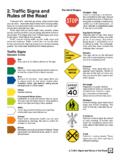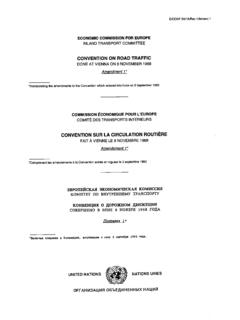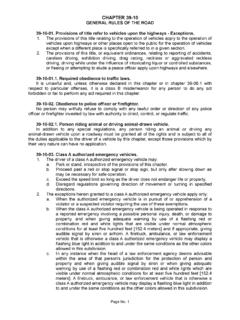Transcription of Ben-Zion Kryger, Chairman, Yad-Haniktafim, Israel on road ...
1 S U M M A R YBA NQUE MONDIALEBA NC O MUNDIALOur roads, which are meant to take us places, often become venues of loss and sources of sorrow. Friends for Life, India, appreciates and supports the initiative WHO is taking to make the world a safer, more responsible place in which to Verghese Koshy, President, Friends for Life, Bangalore, India We, the surviving relatives of the victims of road accidents, appreciate the initiative of WHO and the publication of this report. It is wrong to place the responsibility for causing and preventing road crashes on the driver only; we need to look at the vehicle and the road as Kryger, Chairman, Yad-Haniktafim, Israel There are not many roads, there is a single road that extends across the length and breadth of our vast planet.
2 Each of us is responsible for a segment of that road . The road safety decisions that we make or do not make, ultimately have the power to affect the lives of people everywhere. We are one road one Sobel, President, Association for Safe International road Travel, United States of America The human suffering for victims and their families of road traffic related injuries is incalculable. There are endless repercussions: families break up; high counselling costs for the bereaved relatives; no income for a family if a breadwinner is lost; and thousands of rands to care for injured and paralysed people. Drive Alive greatly welcomes this report and strongly supports its Winslow, Chairman, Drive Alive, South Africa WHO has decided to tackle the root causes of road accidents, a global scourge characteristic of our technological era, whose list of victims insidiously grows longer day by day.
3 How many people die or are injured? How many families have found themselves mourning, surrounded by indifference that is all too common, as if this state of affairs were an unavoidable tribute society has to pay for the right to travel? May this bold report by WHO, with the assistance of official organizations and voluntary associations, lead to greater and genuine awareness, to effective decisions and to deeper concern on the part of road users for the lives of Duhayon, Administrator, Association de Parents pour la Protection des Enfants sur les Routes, BelgiumWorld report on road traffic injury preventionISBN 92 4 159131 5 The European Federation of road traffic Victims is deeply concerned about the millions of deaths, severely disabled victims and often forgotten survivors of road traffic crashes as well as the huge psychological, social and economic impact of these incidents worldwide.
4 We heartily welcome this report and strongly support the call for an effective Haegi, President, European Federation of road traffic Victims, Switzerland road accidents are a never-ending drama. They are the leading cause of mortality among young people in industrialized countries. In other words, they are a health emergency to which governments must find a response, and all the more so because they know what the remedies are: prevention, deterrence and making the automobile industry face up to its responsibilities. This report is a contribution towards the efforts of those who have decided, whether or not after a personal tragedy, to come to grips with this avoidable ve Jurgensen, Founder and Spokesperson, League against road Violence, FranceMany deaths and injuries from road crashes are completely preventable, especially those caused by alcohol or drug-impaired drivers.
5 WHO has done important work by focusing attention on road violence as a growing worldwide public health problem. This report will be a valuable resource for Mothers Against Drunk Driving and its allies in working to stop impaired driving and in supporting the victims of this Wilkerson, Executive Director, Mothers Against Drunk Driving, United States of America The World Health Organization was established in 1948 as a specialized agency of the United Nations serving as the directing and coordinating authority for international health matters and public health. One of WHO s constitutional functions is to provide objective and reliable information and advice in the field of human health, a responsibility that it fulfils in part through its extensive programme of Organization seeks through its publications to support national health strategies and address the most pressing public health concerns of populations around the world.
6 To respond to the needs of Member States at all levels of development, WHO publishes practical manuals, handbooks and training material for specific categories of health workers; internationally applicable guidelines and standards; reviews and analyses of health policies, programmes and research; and state-of-the-art consensus reports that offer technical advice and recommendations for decision-makers. These books are closely tied to the Organization s priority activities, encompassing disease prevention and control, the development of equitable health systems based on primary health care, and health promotion for individuals and communities. Progress towards better health for all also demands the global dissemination and exchange of information that draws on the knowledge and experience of all WHO s Member countries and the collaboration of world leaders in public health and the biomedical ensure the widest possible availability of authoritative information and guidance on health matters, WHO secures the broad international distribution of its publications and encourages their translation and adaptation.
7 By helping to promote and protect health and prevent and control disease throughout the world, WHO s books contribute to achieving the Organization s principal objective the attainment by all people of the highest possible level of report on road traffic injury prevention:summaryEdited byMargie Peden, Richard Scurfield, David Sleet, Dinesh Mohan, Adnan A. Hyder, Eva Jarawan, Colin MathersWorld Health OrganizationGeneva2004 WHO Library Cataloguing-in-Publication DataWorld report on road traffic injury prevention: summary / edited by Margie Peden .. [et al.]. , traffic prevention and control , traffic - trends factors policy health. , MargieISBN 92 4 159131 5 (NLM classification: WA 275) World Health Organization 2004 All rights reserved.
8 Publications of the World Health Organization can be obtained from Marketing and Dissemination, World Health Organization, 20 Avenue Appia, 1211 Geneva 27, Switzerland (tel: +41 22 791 2476; fax: +41 22 791 4857; e-mail: Requests for permission to reproduce or translate WHO publications whether for sale or for noncommercial distribution should be addressed to Publications, at the above address (fax: +41 22 791 4806; e-mail: The designations employed and the presentation of the material in this publication do not imply the expression of any opinion whatsoever on the part of the World Health Organization concerning the legal status of any country, territory, city or area or of its authorities, or concerning the delimitation of its frontiers or boundaries. Dotted lines on maps represent approximate border lines for which there may not yet be full mention of specific companies or of certain manufacturers products does not imply that they are endorsed or recommended by the World Health Organization in preference to others of a similar nature that are not mentioned.))
9 Errors and omissions excepted, the names of proprietary products are distinguished by initial capital World Health Organization does not warrant that the information contained in this publication is complete and correct and shall not be liable for any damages incurred as a result of its named editors alone are responsible for the views expressed in this by minimum by Tushita Graphic and printed in Foreword v Preface vii Acknowledgements xi The fundamentals 1 Introduction 1 A public health concern 1 The social and economic costs of road traffic injuries 2 Changing fundamental perceptions 2 The predictability and preventability of road crash injury 2 The need for good data and a scientific approach 3 road safety as a public health issue 3 road safety as a social
10 Equity issue 4 Systems that accommodate human error 4 Systems that account for the vulnerability of the human body 4 Technology transfer from high-income countries 4 The new model 5 A systems approach 5 Developing institutional capacity 5 Achieving better performance 7 Sharing responsibility 7 Setting targets 8 Building partnerships 9 The global impact 11 Global, regional and country estimates 11 Global, regional and country trends 12 Profile of people affected by road traffic injuries 13 Socioeconomic status and location 14 Other health, social and economic costs 14 Health and social costs 14 Economic costs 15 Need for reliable information 16 Risk factors and interventions 19 Introduction 19 Managing exposure with land-use and transport policy 19 Exposure to risk of road traffic injury 19 Reducing exposure through land-use and transport planning 20 Encouraging the use of safer modes of travel 21 CHAPTER 1.

















